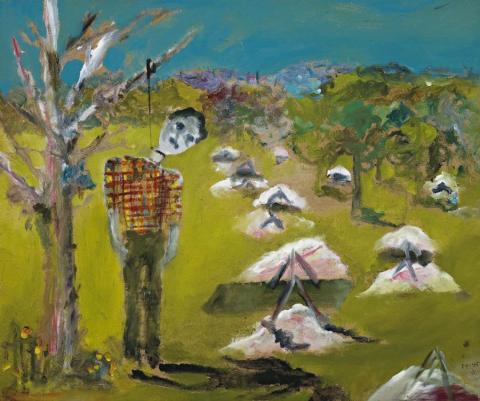GOLDFIELDS, 1945
Sidney Nolan
ripolin enamel on pulpboard
62.5 x 75.0 cm
signed and dated lower right: 8-9-45 / N
inscribed verso: Goldfields / 8-9-45 / nolan
Acquired directly from the artist by Tony Reichardt, London
Marlborough Fine Art, London
Private collection, Queensland
Deutscher~Menzies, Melbourne, 25 April 1999, lot 138
Private collection, Perth
Sidney Nolan – landscapes and legends: a retrospective exhibition 1937 – 1987, National Gallery of Victoria, Melbourne, 3 June – 26 July 1987, then touring nationally
Nolan 1940s–1980s, Deutscher Fine Art, Melbourne, 24 May – 15 June 1996, cat. 2 (illus. in exhibition catalogue)
Side by Side, Art Gallery of Western Australia, Perth, 12 August – 8 Octpber 2000 (label attached verso)
Clark, J., Sidney Nolan – landscapes and legends: a retrospective exhibition 1937 – 1987, International Cultural Corporation of Australia, Sydney, 1987, p. 70 (illus.)
More than any other artist in this country, Sidney Nolan remains celebrated for his legacy of painted images immortalising unforgettable and unforgotten men, heroically failing in their stupendous tasks. Indeed, through his relentless pursuit of the 'heroic' in his art, he has effectively forged what have now become national icons, thereby creating the most enduring mythology of Australian society. Initially attracted to such episodes for the intellectual and aesthetic complexities they afforded - even if that heroism ends in defeat as witnessed with Ned Kelly, or courage in disaster and national trauma, as attested by Gallipoli1 - it is perhaps not surprising that Nolan would eventually seize upon the Eureka Stockade as the theme for one of the most monumental achievements of his career. More akin to a memorial than literal depiction, the mural spanning over twenty metres wide was executed in enamel on copper in London during 1965 and today may be found in the foyer of the Reserve Bank of Australia, Melbourne.
Yet Nolan's interest in mining extended far beyond the moral simplicities and sensational events surrounding this violent episode of Australia's past. As the present work demonstrates, he had been fascinated over two decades earlier by Ballarat and other towns in the goldmining region of Victoria, admiring in particular the oddities of mines and their eccentric characters. A disturbing and passionate work, Goldfields 1945 features the stylised, almost naive portrayal of the darker side of gold fever where failures and the plain unlucky, as usual, outnumbered the lucky and successful, and suicide was not uncommon. Upon first glance, however, the scene is far from realistic, almost approaching the comical " the hanged man's feet are so close to the ground that his attempt at his own life seems nearly as unsuccessful as his search for wealth.2 As one apprehends further the deliberate crudity of the image however, the sense of hopelessness becomes not only poignant but overwhelming.
Although echoing illustrations by contemporary colonial artists such as S.T. Gill's 'Unlucky digger that never returned' in the Victorian Goldfields sketchbook of 1852-53, Nolan's interpretation is decidedly more harsh and shocking in its impact.3 Equally confronting, the companion piece Gippsland Incident 1945 depicts the true story in which a man struck a tree with an axe and found embedded in the trunk the figurehead of a ship that had been wrecked on the Gippsland Coast. The figurehead had floated up and when he hit the tree he decapitated the woman. A truly pathetic episode, the man is clearly disturbed by what he has done, and there is infinite pathos in the way his 'victim' appears to be leaning against his leg in a parody of a tender gesture of companionship.4 Moreover, whether intended by the artist or pure coincidence, one cannot help noticing that the face of the 'murderer' here is very similar to that of the suicide in Goldfields painted just a few days later.
Interestingly, Nolan would revisit the plight of miners time and again throughout his vast and varied oeuvre - most famously in the highly whimsical Pretty Polly Mine of 1948 and colossal Eureka Stockade 1965, and more hauntingly, in the series of large oil paintings depicting the workers at the Mount Tom Price iron ore mines in the Hammersley Ranges of north-western Australia. While undoubtedly conversant with D.H. Lawrence's romantic view of the miner's life, Nolan could not be more antithetical in his interpretation of the theme, as Goldfields tangibly illustrates. Possibly the closest he ever came to social realism (psychologically, at least), indeed his vision is universally bleak and unflinching, his paintings redolent of men brutalised by their working lives.
1. Rosenthal, T.G, Sidney Nolan, Thames and Hudson, 2002, p. 189
2. Ibid., p. 193
3. Clark, J., Sidney Nolan: Landscapes and Legends, A Retrospective Exhibition 1937 -1987 International Cultural Corporation of Australia, 1987, p. 70
4. Rosenthal, op.cit. p. 194
VERONICA ANGELATOS
